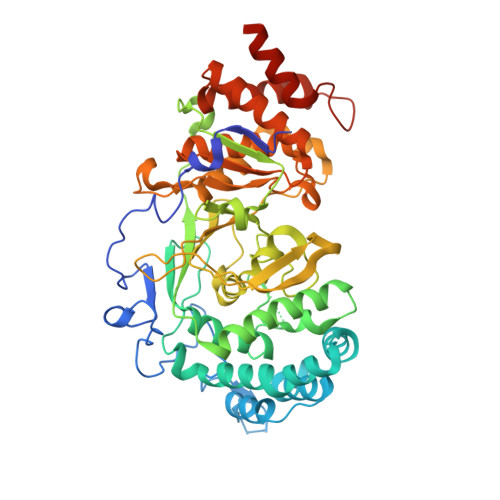Selective small molecule PARG inhibitor causes replication fork stalling and cancer cell death.
Houl, J.H., Ye, Z., Brosey, C.A., Balapiti-Modarage, L.P.F., Namjoshi, S., Bacolla, A., Laverty, D., Walker, B.L., Pourfarjam, Y., Warden, L.S., Babu Chinnam, N., Moiani, D., Stegeman, R.A., Chen, M.K., Hung, M.C., Nagel, Z.D., Ellenberger, T., Kim, I.K., Jones, D.E., Ahmed, Z., Tainer, J.A.(2019) Nat Commun 10: 5654-5654
- PubMed: 31827085
- DOI: https://doi.org/10.1038/s41467-019-13508-4
- Primary Citation of Related Structures:
6O9X, 6O9Y, 6OA0, 6OA1, 6OA3, 6OAK, 6OAL - PubMed Abstract:
Poly(ADP-ribose)ylation (PARylation) by PAR polymerase 1 (PARP1) and PARylation removal by poly(ADP-ribose) glycohydrolase (PARG) critically regulate DNA damage responses; yet, conflicting reports obscure PARG biology and its impact on cancer cell resistance to PARP1 inhibitors. Here, we found that PARG expression is upregulated in many cancers. We employed chemical library screening to identify and optimize methylxanthine derivatives as selective bioavailable PARG inhibitors. Multiple crystal structures reveal how substituent positions on the methylxanthine core dictate binding modes and inducible-complementarity with a PARG-specific tyrosine clasp and arginine switch, supporting inhibitor specificity and a competitive inhibition mechanism. Cell-based assays show selective PARG inhibition and PARP1 hyperPARylation. Moreover, our PARG inhibitor sensitizes cells to radiation-induced DNA damage, suppresses replication fork progression and impedes cancer cell survival. In PARP inhibitor-resistant A172 glioblastoma cells, our PARG inhibitor shows comparable killing to Nedaplatin, providing further proof-of-concept that selectively inhibiting PARG can impair cancer cell survival.
- Departments of Cancer Biology and of Molecular and Cellular Oncology, University of Texas MD Anderson Cancer Center, 6767 Bertner Avenue, Houston, TX, 77030, USA.
Organizational Affiliation:

















